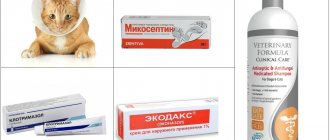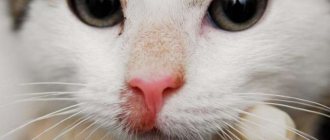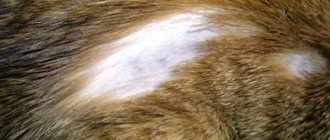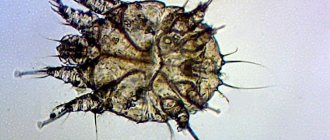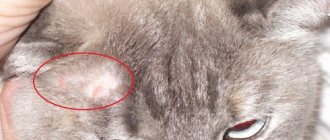Save the article:
If a cat has hairless areas on its body, peeling, redness, itching of the skin, there is a high probability that the pet has contracted lichen .
Ringworm is a highly contagious mycotic disease that affects both animals and humans. The causative agent of the disease is a microscopic fungus of a certain type. Depending on the type of fungus, the disease looks and is treated differently. The same ringworm in a cat can be caused by different fungi.
First, the skin is damaged, then the disease spreads to the fur and claws. First of all, weak or injured animals catch the disease, but good health does not guarantee that the disease will pass by.
global $ads_google; //data-ad-slot=”2475549904″ $ads_google = empty($ads_google) ? false : true; ?> if ($ads_google == false) {?>
$ads_google = true; ?> } ?>
The problem is very serious, and the disease is easily transmitted from cat to person, so when the first symptoms are detected, treatment begins.
Where does a cat get lichen from?
The spores remain viable in unfavorable natural environmental conditions for about two years. The fungus gets onto the animal's fur from the fur of other cats, or from an area where the pet often visits. Disputes can settle on furniture and any area of the apartment. The fungi are viable for about two years, but as soon as they enter a warm, humid environment, they wake up and become infected.
The disease may not manifest itself at first, but after 2-3 months the first signs will become noticeable. Most often, kittens suffer from lichen due to their underdeveloped immune system, weakened older cats, infected with parasites or lacking proper nutrition. Thus, the disease wanders from animal to animal endlessly, unless a person intervenes and treats the pet or its immunity, breaking the chain.
Genetic weakness of immunity to fungal diseases plays a role; exotic breeds are especially vulnerable.
Risk factors and routes of infection
Spores of pathogenic eukaryotes can remain viable for many years, being in a “dormant” state, and when they enter a favorable environment, they begin to actively reproduce. Most cats become infected from their relatives: street animals are very often carriers of a fungal infection.
It is important to know! A cat can “catch” a fungal infection without leaving the house. Microscopic seeds of the fungus can enter the home with dusty air, on dirty shoes, on cat dishes, bedding, and even in water.
Veterinarians consider factors predisposing to the development of dermatomycosis in cats:
- Reduced immunity. In kittens up to one year old, the immune system is not yet sufficiently developed, and in adult cats it may be weakened by some disease.
- Poor nutrition, which reduces the animal’s ability to resist disease.
- Skin damage. It is easier for pathogenic fungi to penetrate the skin if its natural protective barriers are broken.
- Genetic predisposition. It has been established that Persian cats suffer from ringworm more often: this artificially bred breed lacks a gene responsible for fighting certain types of infection, including fungi.
Can a person get shingles from a cat?
It is not difficult for ringworm spores to get on the bare skin of a person, which, unlike animals, is not protected by fur. The infection reaches a person from an infected cat even during the incubation period when touching the fur. Therefore, it is important to understand that an animal that has contracted lichen becomes a carrier of the disease even at the earliest stage.
Immunity plays a big role: children and older people are more susceptible to fungal spores. Treatment is long-term; even a mild form, if treatment is ineffective, develops into a chronic form, which will certainly affect health.
Precautionary measures against infection
You need to know that ringworm is highly contagious for both animals and people. Since this disease is treated at home, you should take some precautions to prevent infecting other members of your family.
Let's look at some of them:
- If you have other animals, you should check them for the presence of this disease.
- The sick animal is isolated in a warm room. This is a lot of stress for your pet, so you should visit your cat as often as possible. People with weak immune systems should avoid visiting.
- If an infection is detected in a cat, the house should be thoroughly cleaned, as the lichen fungus can remain on furniture for a long time.
- Some precautions should be taken when visiting a sick animal. It is necessary to change clothes and carry out treatment with gloves so as not to bring the infection into the house again.
- If your cat has long hair, it should be trimmed.
- You should wash your hands after each visit to a sick pet, and treat any wounds with antiseptic agents.
If you follow all these measures, you can safely treat your pet at home, while eliminating the risk of infection.
Types of lichen in cats
The microorganisms that cause the development of lichen in cats are called Trichophyton, Microsporum canis and Microsporum gypseum. The first pathogen gives the consonant name of the disease trichophathia, and as a result of the influence of Microsporum canis and Microsporum gypseum, microsporia is detected. All three types have identical symptoms, and the ringworm is called ringworm.
In addition to the most common ringworm, there is also pink, oozing, pityriasis versicolor and herpes zoster. Each type has its own external signs and treatment methods.
Ringworm in cats
The fungal disease defined as ringworm in cats also has another name - dermatophytosis. The disease appears as a result of activation of fungi of the genus Microsporum (microsporia) and Trichophyton (trichophyton), penetrating into the superficial subcutaneous layers and feeding on the upper epithelium of the skin.
The disease is especially dangerous for cats with long hair - long hair makes it difficult to discern pathological inflammatory changes on the skin in time.
Ringworm or clipped lichen is a collective image. This term refers to a dermatophytosis range of different pathogens. The fungus, once on the fur, can hide and not show itself for a long time, although the pet will be a source of disease for humans. Externally, in a person, the affected area resembles a ring in shape and necessarily requires treatment.
Symptoms of ringworm
Initially, lichen spots appear on the ears or limbs of cats, resembling scales or grayish ash. The affected areas can be located in different places, and the typical signs of each type are not distinguished separately. Sometimes small ulcers may appear. A small spot gradually grows. Itching is not necessary. When the claws are affected, their abnormal growth and deformation are noticeable.
Most often in cats, ringworm is located on the head, ears or tail. The spots can stretch out, pass through the muzzle, or in advanced cases cover the entire body. The skin at the site of the lesion is greasy and very flaky. Wool can fall out actively and at an average rate; hairballs often form.
Despite the external characteristic signs of lichen, the specialist conducts research and analyzes all data for an accurate diagnosis. The most commonly used method for identifying ringworm in cats is using a Wood's lamp, in the light of which the fungi fluoresce. Trichophytosis does not react to this lamp, and a fungus can be detected on the fur of a healthy pet, although the cat is not infected, so the material from the affected area is examined under a microscope and the fungus is inoculated into a special identification medium.
Treatment of ringworm
It is imperative to treat such a contagious disease, as it can cause many complications. The approach to treatment should be systematic and comprehensive: the treatment regimen includes local and internal antimycotic drugs.
The first step is to treat the affected areas: the hair around them is shaved off and the area is treated with an antiseptic. For a global external attack on the source of the disease, the cat is washed with antifungal shampoo, for example, Nizoral and Sebozol, developed specifically for these purposes. The benefits of these shampoos are based on the component ketoconazole, which actively acts on various fungi.
global $ads_google; //data-ad-slot=”2475549904″ $ads_google = empty($ads_google) ? false : true; ?> if ($ads_google == false) {?>
$ads_google = true; ?> } ?>
Antifungal shampoo alone is not enough; it is only an additional measure to combat diseases, helping to relieve itching and improve the condition of the animal’s skin and coat.
Local treatment is based on taking ointments with an antifungal spectrum of action: Clotrimazole, Miconazole, Sanoderm. The ointments are suitable for both short-haired cat breeds that have contracted lichen infection, and long-haired ones.
The diet of a sick cat should include an additional vitamin and mineral complex.
Contact with other pets and household members is prohibited. Anyone who undertakes to treat an animal must take precautions and wear gloves. The room where the pet is kept must be sanitized regularly.
Pityriasis rosea in cats
A type of herpes zoster, not dangerous to humans , has a complex nature. The cause of the disease is not fungal spores or other microorganisms. First, a pink, clearly defined spot with a diameter of up to 2 cm is noticed on the cat, which can flake and itch. The edges of the spots may be separated by scales.
Pityriasis rosea in cats appears as a result of allergic or infectious factors. The virus can be transmitted to another sick animal, and a cat with a severely weakened immune system is susceptible to the disease. For other animals, this form of the disease, also called Zhiber's lichen, is contagious. But a cat with good immunity is not at risk of transmitting the disease, so the best treatment is proper nutrition for your furry pet.
Pityriasis rosea in a cat can become a kind of indicator of the health of the owner's pet - probably a healthy-looking cat has some hidden pathologies and there is a need for a thorough health check by a veterinarian.
Although a person is not in danger of contracting this type of disease, it is better to protect the animal from other family members until it has fully recovered.
Treatment of pityriasis rosea
Pityriasis rosea is not so terrible, since it is quite capable of disappearing on its own without human intervention. But this is typical for a mild form of the disease.
Since the animal that has contracted the infection is weakened, adjustments are made to its diet: first they include light food, completely removing dry food and allergens. This measure will help relieve itching. Administration of antihistamines is acceptable. If the itching is unbearable and the animal scratches continuously, the veterinarian prescribes non-steroidal anti-inflammatory drugs, which do not treat the disease, but help cope with its manifestations.
A sick cat is not allowed outside, any water treatments are stopped, contact with pets is limited, and care is also taken to ensure that the animal does not lie on the windowsill in the sun.
They especially carefully monitor their diet, selecting vitamin and mineral supplements to boost their pet’s immunity.
Apricot or sea buckthorn oils will help relieve itching and alleviate the condition of exhausted skin.
Ringworm in cats
This skin lesion is not considered lichen in the full sense, because it is caused not by fungi, but by hormonal imbalance, a breakdown of the nervous system, the presence of various parasites or allergies. The disease can also be caused by burns, frostbite, vitamin deficiency or even hypervitaminosis, or be a consequence of a previous illness.
For humans, the so-called weeping eczema is not dangerous.
This type is manifested by the appearance of compacted areas of pink-red skin, with blisters and pustules on the surface.
The disease is characterized by compacted areas of skin, colored pinkish-red, and there may also be the presence of blisters and pustules on the surface. When opened, the wounds ooze and are painful for the pet.
The disease may be accompanied by a feverish state.
Symptoms of weeping lichen
First, red spots are noticed on the animal’s body; their temperature is higher than on other areas of the skin. When the owner tries to touch the spots, the pet’s protest will become obvious - the lesion is very painful.
The area may vary in size, but will be completely blistered and appear wet. When the vesicles rupture, fluid is released, the skin becomes infected, and pustules form.
After treatment, a crust will form at the site of the lesion, but cell renewal will contribute to the rapid growth of new hair.
Treatment of weeping lichen
Treatment must be systematic, stable and in full compliance with the regimen. If the systematicity of the procedures is violated, the disease will drag on and progress with temporary remissions and relapses.
It would be wise to consult a veterinarian for an accurate diagnosis and treatment regimen. Therapy for the disease is quite simple: ointments with a drying effect are used for home treatment.
Salicylic ointment (2-, 5-, 10 percent) is an affordable antiseptic with an astringent effect that will relieve inflammation in a short time. It will take 10-12 days for the skin to recover. The treatment is carried out twice a day, and the area around the lesion is smeared.
An effective remedy with anti-inflammatory, antimicrobial and antimycotic effects is sulfur ointment. The affected areas are treated twice a day for 2-3 weeks. The spot should disappear without a trace, only after this the therapy can be stopped. To prevent the cat from deciding to taste the ointment, you can shave the hair around the spot and make an application, securing it with a band-aid.
Ichthyol ointment is considered a proven remedy that can defeat weeping eczema in a pet in 10 days. Smear it on sore spots twice a day. No less effective is tar ointment, which easily copes with fungi and helps restore the skin. The course of treatment is 10 days.
Pityriasis versicolor in cats
Pityriasis versicolor or pityriasis versicolor in cats can be easily transmitted to both other animals and humans. However, it is not a common disease among pet fur babies. However, at the slightest suspicion of the pityriasis variety, immediately contact a veterinarian, fearing unpleasant consequences for the cat’s health.
A small oval spot found on a cat's body can be pink, pale yellow or even brown. Soon there are more spots, and they gradually merge into one.
This disease is caused by infection with a fungus (yeast), which is of a very pathogenic nature. Surprisingly, fungal spores can be found on the skin of almost every person or animal, but they can only manifest themselves in cases of serious immune disorders. Seborrheic skin and a humid, hot climate are considered especially favorable for the progression of the disease.
Symptoms of pityriasis versicolor
The symptoms of this variety are easily distinguishable:
- multi-colored spots appearing on the skin of the body;
- sometimes the spots look somewhat discolored;
- the surface of the spots can be smooth or resemble scales;
- when the air temperature drops, the lesions disappear and then reappear;
- the absence of itching is considered a characteristic sign for the correct diagnosis of the disease.
Treatment of pityriasis versicolor
In order to cure such cat lichen , medicinal ointments, liniments, powders and antifungal shampoos are used. Sometimes veterinarians recommend oral medications. Treatment is prescribed depending on the factors of the lesion: size, location of the spots, thickness.
global $ads_google; //data-ad-slot=”2475549904″ $ads_google = empty($ads_google) ? false : true; ?> if ($ads_google == false) {?>
$ads_google = true; ?> } ?>
It is recommended to cut cats with long hair during illness - this way it is more likely that the owner will not miss the stain during external treatment.
External treatment products are sold in pharmacies without a prescription. Their composition is effective only for mild cases of infection, so treatment must be comprehensive. Oral remedies allow you to cope with the disease many times faster, saving time, effort and financial costs.
Such products as Imaverol (based on enilconazole) and Lime Sulfur (based on hydrogen sulfide of lime) have proven themselves to be excellent.
However, it is worth considering the possibility of side effects, therefore it is recommended to use such drugs strictly after visiting and consulting a veterinarian.
To prevent a possible relapse, the cat is washed 2-3 times a month with antifungal shampoos, especially if the animal lives in a humid and hot climate.
Shingles in cats
For some reason, there is still a misconception around the world that shingles is the privilege of cats and dogs. This type of infectious disease affects only people - the disease is caused by the chickenpox virus. No matter how much they want, cats cannot become infected with it.
There is a possibility that some other type common to pets is attributed to shingles in cats.
What is lichen
Feline ringworm is a common disease caused by fungi or viruses that affects the fur, skin and claws of animals.
The infection is most often caused by dermatophytes of the Microsporum and Trichophyton species. Therefore, the disease is called microsporia, trichophytosis or dermatophytosis in cats.
Most often identified:
- Dermatophytes Microsporum canis - transmitted by contact with other animals.
- Microsporum gypseum - infection occurs upon contact with the ground.
- Microsporum mentagrophytes are transmitted by rodents.
If the skin, hair and claws are affected by fungi other than dermatophytes, the disease is classified as dermatomycosis in cats.
Depending on the fungus, the types of lichen in cats, symptoms and treatment are divided.
The collective name for fungal infection is dermatophytosis. There is also an unofficial concept - ringworm. When the skin and fur are affected, the hairs become brittle. The rods break off almost at the base, a bald spot appears and it seems that the cat has been shorn in this place. Hence the name.
Ringworm is a self-healing disease. Thus, short-haired cats and animals with strong immunity recover on their own within 3 months. In long-haired breeds, self-healing is possible, but only over a longer period - from 1.5 to 4 years.
If an animal develops lichen and then disappears, this does not mean that the cat is healthy. On the contrary, it can be a source of infection.
If lichen in pregnant cats
Caring for cat offspring excludes the use of antifungal agents in a pregnant cat infected with lichen. In this case, herbal medicine comes to the fore. Traditional medicine treated this disease before the development of industrial medicines, so you can rely on proven herbs: oregano, burdock, yarrow, tricolor violet, common valerian and some others.
Herbs can be combined in a recipe or used individually.
Stinging nettle, oregano, tricolor violet - these effective herbs are used in dried form. Take 1 part of each herb and mix. Brew 2 tbsp in 500 ml of boiling water. dry raw materials. After 20 minutes of infusion, the medicine is filtered and offered to the cat up to 4 times a day in the form of a warm drink half an hour before meals. Treatment is continued until recovery.
If the cat refuses to drink, then it is advisable to include valerian in the recipe.
Lesions can be treated externally with diluted tea tree oil. This is an excellent antimycotic agent, but it is not used in its pure form, but diluted in olive or peach oil (4 drops per tablespoon). Apply stains three times a day until they disappear completely.
The nature of lichen and the risk group for infection with it
The main thing you need to understand is that lichen is not a diagnosis. This term refers to several skin diseases, conditionally similar in symptoms, but completely different in the causes of occurrence, methods of treatment, its duration and complexity. Let's say more: not all types of lichen are contagious.
Not all types of lichen in animals are contagious to humans
The factor that unites different diseases under the general name “lichen” is the main symptom - rashes or spots on the skin, accompanied by peeling and itching.
In cats this usually manifests itself as:
- the appearance of bald spots, usually starting from the head and, as a rule, with clear boundaries;
- redness of the skin in exposed areas and the appearance of scratching on it (evidence of severe itching);
- the presence of inflammation, ulcers, blisters with liquid, peeling on the skin;
- claw deformities.
However, such a clinical picture can be caused by the action of various pathogens (bacteria, viruses, fungi) or have a neurological or even allergic nature. It is clear that in the last two cases the disease is not dangerous for others.
However, there is one more common feature among all types of lichen. This disease in any of its manifestations always affects an organism with a weakened immune system, and this rule applies equally to both animals and people. A baby is much more likely to catch shingles from a sick cat than his parents.
In children, the risk of contracting deprivation is always higher than in adults, due to the immature immune system.
If we talk about cats, lichen most often affects:
- pregnant cats;
- nursing mothers;
- kittens;
- elderly animals;
- cats who have suffered a serious illness;
- hungry and weakened animals.
Photo gallery: cats at risk for lichen infection
Pregnancy is stressful for a cat’s body; the immune system is weakened during this period.
A nursing cat's risk of contracting shingles increases.
In old age, a cat's body loses its ability to resist infection.
Previous illness or surgery also weakens the immune system.
A stray animal weakened by hunger is more susceptible to contracting lichen.
There are many cats living around our summer cottage, and they all sometimes come to us for a treat. Somehow after winter, we discovered that one of these cats, in addition to her usual pregnancy, had obvious symptoms of lichen. The animal's condition worsened every day, and the disease progressed. But here's what's interesting: several other cats that were in direct contact with the infected animal remained completely healthy. In the end, through our joint efforts, we managed to defeat the disease, but none of the other animals became infected.
In people, in addition to childhood or old age, pregnancy and previous diseases, the risk group can be supplemented by such factors as:
- experienced stress;
- heavy physical activity, in particular, accompanied by profuse sweating;
- predisposition to allergies;
- individual characteristics of the body (hereditary factor);
- violation of personal hygiene rules;
- use of certain medications;
- certain diseases (chicken pox, candidiasis, problems with the endocrine system, dysbacteriosis, autoimmune, infectious diseases, etc.);
- alcoholism.
The appearance of lichen can be triggered even by simple stress
Thus, contact with a sick cat is not the most common and far from the only way to become familiar with such an ailment as lichen.
Treatment of lichen at home
To cure your pet you will need to follow a number of rules:
- The room where the cat is kept must be regularly cleaned and disinfected. Sterility is the enemy of fungi;
- ointments and sprays are used to treat foci of the pet’s disease 2-3 times a day for 2 weeks;
- wash the cat with antifungal shampoos twice a week for 6 weeks;
- Injections against feline lichen . There are contraindications for pregnant women, nursing kittens and kittens under 2 months. The prices for lichen vaccines for cats are low, but the effect is excellent;
- the use of griseofulvin, itraconazole, and ketonazole tablets. The drugs are given every 12 hours at a dose of 5-10 mg per 1 kg of body weight;
- stains can be treated with iodine, which will promote their speedy healing.
Routes of transmission of ringworm
Spores of the fungus that causes the disease can spread quickly through the air, in the aquatic environment and through clothing.
Main routes of transmission:
- in direct contact with a sick animal (if protective equipment is not used);
- with indirect contact, infection can occur through pet care items - a bed, food bowls, harness or leash;
- through other carriers of infection - rodents (mice and rats);
- in the environment, spores can spread with water or through the air, through soil, sand, garbage, upon contact with which the fungus begins to develop;
- through items of clothing or shoes of the owner or other people coming into the house.
If a person is infected with shingles
A person who keeps furry pets in the house must be prepared for the fact that some diseases can spread from a sick cat to all family members.
Treatment of a person infected with lichen from a cat is carried out in parallel with the treatment of a pet. Complex therapy is used:
- all sore spots are treated with antifungal ointments, iodine, fucarcin;
- during treatment, do not take a bath or rub the skin with a washcloth;
- take antifungal and antihistamines orally;
- The diet includes a complex of vitamins.
Is ringworm transmitted to humans?
The main danger of the disease is that lichen is contagious to humans. In this case, people can be affected in any part of the body (arms, legs, etc.), often the skin under the hair on the head. Pink spots appear with clear edges. They may be slightly raised above the skin. Hair on the spots always falls out and grows back only after the end of the course of therapy and cure.
Most often, children of preschool age, who have not yet developed immunity, and adults who have a weak immune system are infected with lichen. In people with a strong, healthy body and high immunity, fungal spores can live on the skin for quite a long time and remain in a suppressed state.
Prevention of feline lichen
Deprivation in a cat can be avoided thanks to preventive measures:
- the house must be clean, and the cat’s sleeping area must be disinfected regularly;
- furniture surfaces are wiped with a bleach solution once a week;
- It is not advisable for the pet to have contact with stray cats and dogs;
- The cat's diet must be balanced and contain all important vitamins, micro- and macroelements.
- Preventive measures also include regular examination by a veterinarian, who can immediately detect the first symptoms of an incipient disease and prescribe adequate treatment.
global $ads_google; //data-ad-slot=”2475549904″ $ads_google = empty($ads_google) ? false : true; ?> if ($ads_google == false) {?>
$ads_google = true; ?> } ?>
As already mentioned, the disease is more often contracted by animals with weakened immune systems, as well as kittens and older cats. This is a risk group that requires more attentive care and quality nutrition.
Symptoms
At the initial stage, lichen manifests itself in the form of focal manifestations of a rash caused by the death of affected skin cells.
There are also a number of secondary signs of the disease :
- animal anxiety;
- frequent scratching of the affected areas of the skin, sometimes to the point of bleeding;
- dandruff;
- dull coat;
- local redness of the skin;
- darkening of the skin;
- hair loss.
As the disease progresses, the scratched areas gradually become covered with keratinized scales and dried crusts of blood. Hair loss becomes more abundant: pronounced bald spots and bald patches form on the animal’s body. The skin in bald areas may peel off.
In the photo below you can see what ringworm looks like in cats.
On what parts of the body does ringworm concentrate?
The fungus mainly affects the head of animals and only then, when the cat, under the influence of itching, begins to scratch the affected area, does it spread to other parts of the body. The first foci of infection appear on the ears.
If proper measures are not taken in time, fungal spores will spread to the animal’s paws, tail and belly . Cats may then begin to develop larger bald spots on their backs and sides, as seen in the following pictures:
